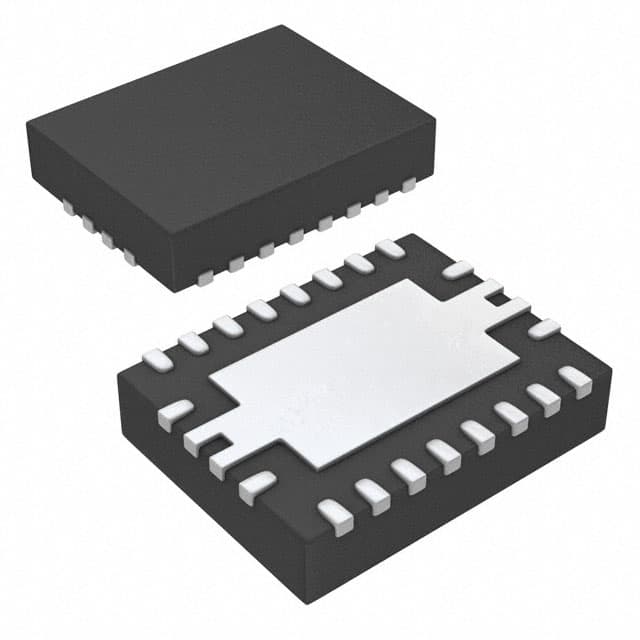Xem thông số kỹ thuật để biết chi tiết sản phẩm.

BQ24030IRHLRQ1 - English Editing Encyclopedia Entry
Product Overview
Category
BQ24030IRHLRQ1 belongs to the category of integrated circuits (ICs) specifically designed for battery charging applications.
Use
This product is primarily used for charging single-cell lithium-ion or lithium-polymer batteries in various portable electronic devices, such as smartphones, tablets, and wearable devices.
Characteristics
- Input voltage range: 4.35V to 6.45V
- Output voltage range: 3.5V to 4.44V
- Charging current: Up to 1.5A
- Programmable charge termination current
- Thermal regulation and protection
- Integrated power FET
- Small form factor package
Package and Quantity
The BQ24030IRHLRQ1 is available in a compact 20-pin VQFN package. It is typically sold in reels containing a quantity of 2500 units.
Specifications
- Input Voltage Range: 4.35V to 6.45V
- Output Voltage Range: 3.5V to 4.44V
- Charging Current: Up to 1.5A
- Charge Termination Current: Programmable
- Operating Temperature Range: -40°C to +85°C
- Package Type: 20-pin VQFN
Pin Configuration
The BQ24030IRHLRQ1 features the following pin configuration:
- EN (Enable)
- STAT (Status)
- PG (Power Good)
- TS (Thermal Sense)
- ISET (Charge Current Set)
- VSS (Ground)
- VSS (Ground)
- VSS (Ground)
- VSS (Ground)
- VBAT (Battery Voltage)
- VBUS (Input Voltage)
- VSS (Ground)
- VSS (Ground)
- VSS (Ground)
- VSS (Ground)
- VSS (Ground)
- VSS (Ground)
- VSS (Ground)
- VSS (Ground)
- VDD (Supply Voltage)
Functional Features
- Integrated power FET for efficient charging
- Programmable charge termination current for flexible battery charging
- Thermal regulation and protection to prevent overheating
- Enable pin for easy control of charging process
- Status and power good pins for monitoring charging status
Advantages and Disadvantages
Advantages
- High charging current capability allows for faster charging times
- Programmable charge termination current enables customization for different battery types
- Integrated power FET simplifies circuit design and reduces external component count
- Thermal regulation and protection ensure safe and reliable charging
Disadvantages
- Limited input voltage range may not be suitable for all applications
- Package size may pose challenges in space-constrained designs
Working Principles
The BQ24030IRHLRQ1 operates by regulating the charging current and voltage supplied to the connected lithium-ion or lithium-polymer battery. It utilizes an integrated power FET to efficiently transfer power from the input source to the battery. The charge termination current can be programmed to suit different battery capacities, ensuring optimal charging performance. The device also incorporates thermal regulation and protection mechanisms to prevent overheating and ensure safe operation.
Application Field Plans
The BQ24030IRHLRQ1 is widely used in various portable electronic devices that require single-cell lithium-ion or lithium-polymer battery charging capabilities. Some specific application fields include:
- Smartphones and tablets
- Wearable devices (smartwatches, fitness trackers)
- Portable medical devices
- Portable audio players
- Handheld gaming consoles
Alternative Models
For those seeking alternative options, the following models provide similar functionality to the BQ24030IRHLRQ1:
- MCP73831T-2ACI/OT
- MAX1555EZK+T
- LTC4054LES5-4.2#TRMPBF
- TPS2513EVM-001
These alternatives offer comparable charging capabilities and features, providing flexibility in choosing the most suitable solution for specific applications.
In conclusion, the BQ24030IRHLRQ1 is a versatile integrated circuit designed for efficient and reliable charging of single-cell lithium-ion or lithium-polymer batteries. Its programmable charge termination current, thermal regulation, and compact package make it an ideal choice for various portable electronic devices.
Liệt kê 10 câu hỏi và câu trả lời thường gặp liên quan đến ứng dụng BQ24030IRHLRQ1 trong giải pháp kỹ thuật
Sure! Here are 10 common questions and answers related to the application of BQ24030IRHLRQ1 in technical solutions:
1. What is the BQ24030IRHLRQ1? - The BQ24030IRHLRQ1 is a highly integrated standalone linear Li-Ion battery charger with thermal regulation.
2. What is the input voltage range for the BQ24030IRHLRQ1? - The input voltage range for the BQ24030IRHLRQ1 is from 4.35V to 6.45V.
3. What is the maximum charging current supported by the BQ24030IRHLRQ1? - The BQ24030IRHLRQ1 supports a maximum charging current of 1A.
4. Can the BQ24030IRHLRQ1 charge multiple batteries simultaneously? - No, the BQ24030IRHLRQ1 is designed to charge a single Li-Ion battery at a time.
5. Does the BQ24030IRHLRQ1 have overvoltage protection? - Yes, the BQ24030IRHLRQ1 has built-in overvoltage protection to prevent damage to the battery.
6. Is the BQ24030IRHLRQ1 suitable for fast charging applications? - No, the BQ24030IRHLRQ1 is not specifically designed for fast charging applications. It is more suitable for slower charging scenarios.
7. What is the operating temperature range for the BQ24030IRHLRQ1? - The BQ24030IRHLRQ1 has an operating temperature range of -40°C to +85°C.
8. Does the BQ24030IRHLRQ1 have a thermal regulation feature? - Yes, the BQ24030IRHLRQ1 has a built-in thermal regulation feature to prevent overheating during charging.
9. Can the BQ24030IRHLRQ1 be used in automotive applications? - Yes, the BQ24030IRHLRQ1 is qualified for automotive applications and meets AEC-Q100 standards.
10. What are the typical applications of the BQ24030IRHLRQ1? - The BQ24030IRHLRQ1 is commonly used in portable devices, handheld instruments, and other battery-powered applications that require a standalone linear charger.
Please note that these answers are based on general information about the BQ24030IRHLRQ1 and may vary depending on specific use cases and requirements. It is always recommended to refer to the datasheet and consult with the manufacturer for detailed technical information.

